Complex Stellar Systems

HST/ACS Treasury Survey of the Coma Galaxy Cluster
collaborators: David Carter, Harry Ferguson, Paul Goudfrooij, Bahram Mobasher and the Coma Survey Team
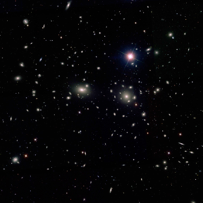
The ACS Coma Cluster survey is an HST Treasury program (GO-10861) awarded 164 orbits in Cycle 15 to provide a comprehensive dataset on samples of thousands of galaxies down to MV ~ -9 mag. It involves more than 30 research astronomers from nine nations. The goal is to image 740 square arcmin of sky using Hubble's Advanced Camera for Surveys (ACS) F475W (blue) and F814W (red) filters. The selected areas cover both the core (see above) and infall region (see below) of this rich galaxy cluster.
About 30% of the survey was completed before the ACS failure.
As a member of the core team, I am leading the effort to analyze the population of bright globular clusters and ultra-compact dwarfs in Coma.
The Coma cluster provides the opportunity to study galaxies in an environment complementary to that observed in any previous large HST program. The Coma core is the densest galaxy environment in the local universe. As such, it provides a key local, high-density benchmark for comparisons to surveys of less-dense and relaxed environments (e.g. Virgo, Fornax, and Perseus galaxy clusters), as well as to high-redshift HST cluster surveys and field surveys such as HUDF, GOODS and GEMS.
The HST/ACS Coma Cluster Survey. I. Survey Objectives and Design
Carter et al. (2008), ApJS 176, 424
The HST/ACS Coma Cluster Survey. II. Data Description and Source Catalogs
Hammer et al. (2010), ApJ in press
The HST/ACS Coma Cluster Survey. V. Compact stellar systems in the Coma Cluster
Price et al. (2009), MNRAS 397, 1816
Structural Parameters of Globular Clusters in the Fornax Galaxy Cluster
collaborators: Maurizio Paolillo, et al.
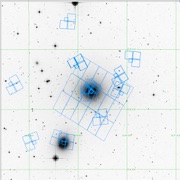
Star cluster systems have proven to be good tracers of galaxy formation and evolution, but the physical processes which lead to star cluster formation are still not well understood. One path to a detailed picture of star cluster formation is the analysis of star cluster structural parameters. Previous studies have found that metal-rich globular clusters are on average 20% smaller than their metal-poor counterparts.
The core of the nearby Fornax galaxy cluster provides us with a rich laboratory of thousands of star clusters. With the Advanced Camera for Surveys onboard the Hubble Space Telescope, we are analyzing the sizes of star clusters in and around NGC 1399, a massive elliptical galaxy located at the core of the Fornax cluster. If the size difference between metal-rich and metal-poor clusters is confirmed at large galactocentric radii, this may imply that the formation of star clusters could depend on the metallicity of the parent gas cloud.
Intermediate-Age Star Clusters in the Local Group
collaborators: Paul Goudfrooij, Rupali Chandar, Tom Brown
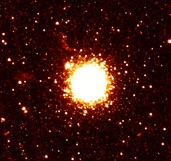
An accurate knowledge of stellar populations of “intermediate” age (1−3 Gyr)
is important within the context of several hot topics in astrophysics. Intermediate-age stars typically dominate the emission observed from galaxies at high redshift. Furthermore, star clusters in this age range are critical for testing predictions of the dynamical evolution of stellar systems and for understanding the evolution of intermediate-mass stars.
Recent studies find evidence for a wide range in turnoff colors and magnitudes, consistent with prolonged early star formation of about 200 Myr. A number of star clusters, primarily massive old globular clusters in the Milky Way have also been shown to have unusual color-magnitude diagrams, suggestive of multiple stellar populations with variations in either age or abundance.
And this is how we do it:
Population Parameters of Intermediate-Age Star Clusters in the Large Magellanic Cloud, I. NGC 1846 and its Wide Main-Sequence Turnoff
P. Goudfrooij, T.H. Puzia, V. Kozhurina-Platais, & R. Chandar 2009, AJ 137, 4988
Panchromatic Reference Database of nearby Globular Clusters
collaborators: Peter Pessev, Paul Goudfrooij, Rupali Chandar
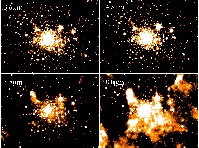
Nature provides us with a rich population of nearby globular clusters that are characterized by essentially a single age and chemical composition. Because we can resolve them into individual stars, these stellar systems are used in a number of ways, from understanding stellar evolution, to probing galaxy formation, to the use as templates to calibrate population synthesis models. Our team assembled a large database of photometric and spectroscopic observations from space-based and ground-based facilities. These data cover a broad wavelength range from the ultraviolet to the infrared, and are currently used to calibrate existing simple stellar population models. Future projects include the computation of new population synthesis models, which will include short-lived stellar evolutionary phases.
A Comparison of Optical and Near-Infrared Colors of Magellanic Cloud Star Clusters with Predictions of Simple Stellar Population Models
Pessev et al. (2008), MNRAS, 385, 1535
A Database of 2MASS Near-Infrared Colors of Magellanic Cloud Star Clusters
Pessev et al. (2006), AJ, 132, 781
Formation Models of Extragalactic Globular Cluster Systems
collaborators: Antonio Pipino, Francesca Matteucci
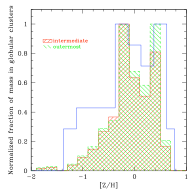
The most massive elliptical galaxies show a prominent multi-modality in their globular cluster system color distributions. Understanding the mechanisms which lead to multiple globular cluster sub-populations is essential for a complete picture of massive galaxy formation.
By assuming that globular cluster formation traces the total star formation and taking into account the radial variations in the composite stellar populations predicted by the Pipino & Matteucci (2004) multi-zone photo-chemical evolution code, we computed the distribution of globular cluster properties as a function of galactocentric radius, and find excellent agreement with spectroscopic observations of globular clusters in massive elliptical galaxies.
These models are currently being expanded to incorporate hierarchical galaxy formation.
The Formation of Globular Cluster Systems in Massive Early-Type Galaxies: Globular Cluster Multi-Modality from Radial Variations of Stellar Populations
Pipino et al. (2007), ApJ 665, 295
Globular Clusters in Dwarf Galaxies
collaborators: Margarita Sharina, Iskren Georgiev, Paul Goudfrooij, Rupali Chandar
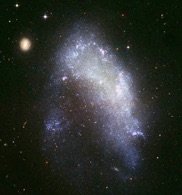
Globular clusters are found in virtually every galaxy. The hierarchical structure formation scenario predicts that dwarf galaxies are the first systems to form in the Universe, and that more massive galaxies form through dissipative processes from these smaller sub-units. By understanding the similarities and differences of globular cluster properties in giant and dwarf galaxies, we can hope to tag individual clusters and decide whether they were formed in a massive or low-mass host galaxy.
Nearby dwarf galaxies appear to be extremely efficient in forming massive star clusters during their entire evolution history through mechanisms which are not fully understood. We surveyed nearby dwarf galaxies with the Hubble Space Telescope and found significant populations of candidate globular clusters. Few of those galaxies were followed-up with spectroscopic observations and confirmed almost all candidates.
Globular Cluster Systems in Nearby Dwarf Galaxies: III. Formation efficiencies of old globular clusters
Gerogiev et al. (2010), MNRAS 406, 1967
Globular Cluster Systems in Nearby Dwarf Galaxies: II. Nuclear Star Clusters and their Relation to Massive Galactic Globular Clusters
Gerogiev et al. (2009), MNRAS 396, 1075
Globular Cluster Systems in Nearby Dwarf Galaxies: I. HST/ACS Observations and Dynamical Properties of Old Globular Clusters at Low Environmental Density
Georgiev et al. (2009), MNRAS 392, 879
Old Globular Clusters in Magellanic-Type Dwarf Irregular Galaxies
Georgiev et al. (2008), AJ 135, 1858
Ages, Metallicities, and [alpha/Fe] Ratios of Globular Clusters in NGC 147, NGC 185, and NGC 205
Sharina et al. (2006), MNRAS, 372, 1259
Hubble Space Telescope Imaging of Globular Cluster Candidates in Low Surface Brightness Dwarf Galaxies
Sharina et al. (2005), A&A, 442, 85
Spectroscopy of Extragalactic Globular Cluster Systems
collaborators: Markus Kissler-Patig, Paul Goudfrooij, Rupali Chandar, Eric Peng et al.
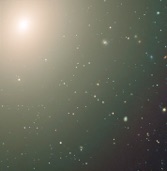
Globular clusters form during major star formation periods and are excellent tracers of the formation, evolution, and chemical enrichment history of galaxies. During my PhD thesis work, I conducted the first spectroscopic survey of extragalactic globular cluster systems outside the Local Group.
We found evidence for younger, more metal-poor, and less alpha-enhanced star cluster systems in less massive galaxies, a typical signature of the downsizing scenario. In addition, we discovered a population of highly alpha-enhanced star clusters which seems to reside only in the most massive elliptical galaxies. Those star clusters show enrichment signatures that are consistent with very massive type-II or pair-instability supernova ejecta.
We are currently expanding our survey to star clusters in low-mass galaxies.
VLT Spectroscopy of Globular Clusters in Low Surface Brightness Dwarf Galaxies
Puzia & Sharina (2008), ApJ, 674, 909
Extremely alpha-Enriched Globular Clusters in Early-Type Galaxies: A Step towards the Dawn of Stellar Populations?
Puzia et al. (2006), ApJ, 648, 383
VLT Spectroscopy of Globular Cluster Systems, II. Spectroscopic Ages, Metallicities, and [alpha/Fe] Ratios of Globular Clusters in Early-Type Galaxies
Puzia et al. (2005), A&A, 439, 997
VLT Spectroscopy of Globular Cluster Systems, I. The Photometric and Spectroscopic Dataset